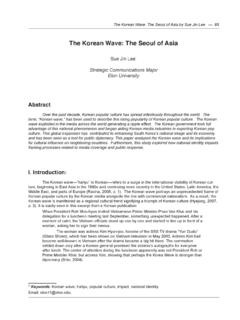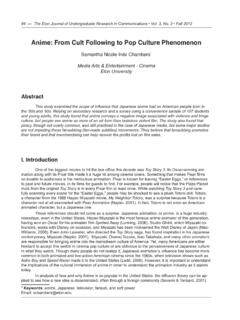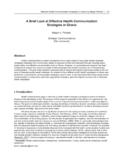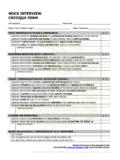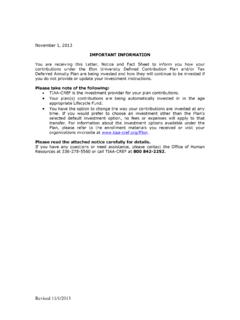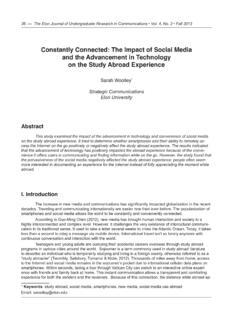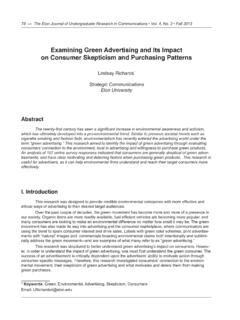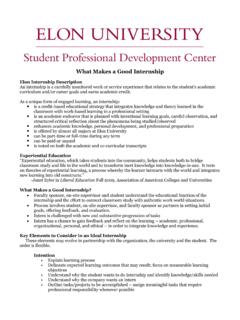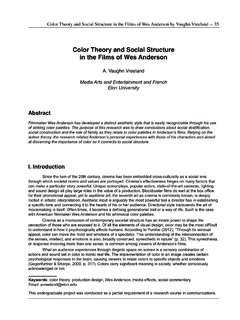Transcription of ELON JOURNAL
1 ELON JOURNAL . OF UNDERGRADUATE RESEARCH IN. COMMUNICATIONS. Fall 2017. VOLUME 8, NO. 2. Joining the World of Journals Welcome to the nation's first and only undergraduate research JOURNAL in communications. The website of the Council on Undergraduate Research lists more than 200 undergraduate research journals nationwide ( ). Some of these journals focus on a discipline ( , JOURNAL of Undergraduate Research in Physics), some are university-based and multidisciplinary ( , MIT Undergraduate Research JOURNAL ), and others are university-based and disciplinary ( , Harvard Political Review). The Elon JOURNAL focuses on undergraduate research in journalism, media and communications. The School of Communications at Elon University is the creator and publisher of the online JOURNAL . The first issue was published in spring 2010 under the editorship of Dr. Byung Lee, associate professor in the School of Communications.
2 The three purposes of the JOURNAL are: To publish the best undergraduate research in Elon's School of Communications each term, To serve as a repository for quality work to benefit future students seeking models for how to do undergraduate research well, and To advance the university's priority to emphasize undergraduate student research. The Elon JOURNAL is published twice a year, with spring and fall issues. Articles in the JOURNAL may be downloaded, reproduced and redistributed without permission for non- commercial purposes as long as the author and source are properly cited. Student authors retain copyright ownership of their works. Celebrating Student Research This JOURNAL reflects what we enjoy seeing in our students -- intellectual maturing. As 18-year-olds, some students enter college possibly wanting to earn a degree more than they want to earn an education.
3 They may question whether communication theory and research have anything to do with their future. But they get excited at studying great ideas and topical issues. These published articles make us aware of the solitary hours that students spend in research and the untold hours in which student and teacher-mentor work together to revise a paper for public consumption. This JOURNAL celebrates the life of the intellect through undergraduate research. It represents the intellectual maturing that occurs by the senior year, reinforcing all that we think a university should be. Dr. Paul Parsons, Dean School of Communications Editorial Board Twenty-eight faculty members in Elon's School of Communications served as the Editorial Board that selected 11 undergraduate research papers for the 2017 fall issue. From more than 100 research papers written in advanced Elon School of Communications classes, 32.
4 Papers were submitted to the JOURNAL by communications students through the encouragement and mentoring of capstone teachers and other professors in the school. Professors who served as the Editorial Board were Lorraine Ahearn, Bill Anderson, Janna Anderson, Vanessa Bravo, Naeemah Clark, David Copeland, Vic Costello, Kelly Furnas, Kenn Gaither, Jessica Gisclair, Don Grady, Sana Haq, Anthony Hatcher, Dan Haygood, Jooyun Hwang, Derek Lackaff, Harlen Makemson, Barbara Miller, William Moner, Phillip Motley, Tom Nelson, George Padgett, Paul Parsons, Glenn Scott, Jessalynn Strauss, Amanda Sturgill, Hal Vincent, and Qian Xu. Thanks also go to Bryan Baker, who recorded the website's student introductions; Associate Dean Don Grady, who reviewed articles to help ensure the quality of the JOURNAL ; and Tommy Kopetskie, who proofread articles and updated the publication's website.
5 Editor's Note Among many topics covered in this issue, four articles covered the analysis of print media and social media content. Two articles critiqued the content of TV programs. Four papers dealt with the effects of media contents on consumers. Lastly, two papers described changes of commercial packages and the application of advanced technology to social media, respectively. After analysis of two Greek newspapers about a referendum on a financial bailout, Rempoutzakos showed that both papers employed framing techniques to promote their agenda and portray the referendum along the frames of YES and NO referendum campaigns in general. After analyzing articles from the 24 issues of Cosmopolitan, Hunsberger found content fluctuated between the negative and positive framing of feminist ideas and these messages mostly did not align with second-wave feminism.
6 Dunne found that three newspapers framed opioid addiction as a public health issue and were more favorable to its victims in comparison with the crack epidemics in the late 1980s. Finally, Anderson studied the tweeting habits of Donald Trump and found that the president uses the social media platform to criticize both Republican and Democrat lawmakers, employs tactics to delegitimize the press, and receives high levels of engagement. Through extensive literature review, Herndon found that sitcoms like Seinfeld emphasized consumption and communality within the show and did not accurately represent class structure. O'Hern analyzed six TV shows to determine the prevalence and frequency of negative bipolar disorder stereotypes in 21st century television. The author found some recent progress, but suggested rooms for improvements in characterizations.
7 Maloney found that the Kardashian-Jenners had an unintended effect on fourth-wave feminism by sharing a semi-positive, non-purposeful feminist message with their target audience of women ages 18-34. After examining social media influencer marketing, Glucksman concluded that it has successfully changed the way that brands interact with consumers by breaking down the wall between the two. According to Osgood's study, a majority of social media users have been exposed to videos like Buzzfeed's Tasty videos, but most users have not consumed the content for cooking, but as a form of entertainment. After examining the websites of the three highest-valued franchises within the NFL teams, Echevarria found that they incorporated comprehensive branding strategies on their webpages to showcase their brand personality and interact with fans. Chili analyzed the packages designs of granola bar brands and cereal brands and found that they were designed to communicate specific messages that shifted over time.
8 Allsteadt found that the integration of advanced technology into social media application design will enhance consumer convenience but may create challenges because businesses need to maintain trust from consumers. These students who had their papers accepted for publication in this issue should be congratulated for writing excellent research papers within a short period of time. Of course, as they acknowledged, it would not be possible without the guidance of their mentors and reviewers. I hope the articles in this issue will inspire students in future semesters to commit to examining essential research questions and submit their papers to this JOURNAL . Dr. Byung Lee JOURNAL Editor Elon JOURNAL of Undergraduate Research in Communications Volume 8, No. 2 Fall 2017. Framing Theory in Newspaper Coverage of the 2015 Greek Referendum Filippos Rempoutzakos 6.
9 The Framing of Feminism in Cosmopolitan Magazine During Second-Wave Feminism Ashley Hunsberger 16. An Investigation of Print Media's Portrayal of the Opioid Epidemic Allison D. Dunne 27. Tweeter-in-Chief: A Content Analysis of President Trump's Tweeting Habits Bryan Anderson 36. The Influence of the Kardashian-Jenners on Fourth Wave Feminism Through Digital Media Platforms Abbey Rose Maloney 48. Seinfeld and the American Sitcom as a Catalyst for Youth Socialist Values Mitch Herndon 60. An Analysis of Bipolar Disorder Stereotypes in 21st century Television Programming Declan O'Hern 67. The Rise and Success of Social Media Influencer Marketing on Lifestyle Branding: A Case Study of Lucie Fink Morgan Glucksman 77. Finding the Purpose of Tasty Videos According to Social Media Audiences Nicole A. Osgood 88. A Content Analysis of NFL Team Online Branding Rachel M.
10 Echevarria 96. How the Designs and Messages of Granola Bar and Cereal Packaging Have Changed Over 10 Years Maddie Chili 105. An Exploration into the Effect of Advancing Technology on UX of Social Media Applications Cameron Allsteadt 121. 6 Elon JOURNAL of Undergraduate Research in Communications, Vol. 8, No. 2 Fall 2017. Framing Theory in Newspaper Coverage of the 2015 Greek Referendum Filippos Rempoutzakos Strategic Communications and Religious Studies Elon University Submitted in partial fulfillment of the requirements in an undergraduate senior capstone course in communications Abstract In 2015, the Greek prime minister announced a referendum on the country's proposed debt bailout. Media outlets shaped the referendum into YES and NO frames based on their political spectrum. A week after the referendum announcement, the Greek people overwhelmingly voted to oppose the creditors' measures.

